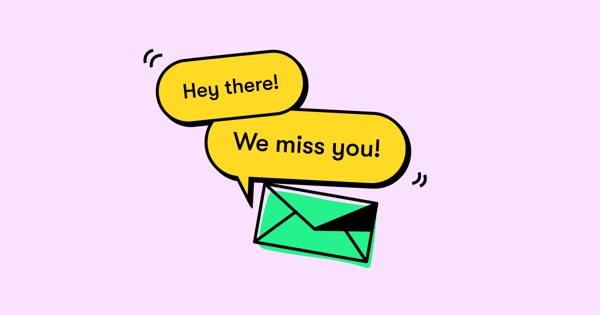Growing an email marketing list is a constant battle. It’s hard enough persuading potential customers to sign up in the first place.
But for many brands, it’s even harder to keep them engaged weeks, months, or years down the line.
According to one study, email list churn chews up and spits out 25-30 percent of the average email list per year.
So if you start the year with 10,000 subscribers, you can expect to shed up to 3,000 of them over the next 12 months.
In other words, you need to sign up another 3,000 people just to “break-even”.
That’s tough.
But it gets a little easier if you can find an effective way to re-engage lapsed subscribers before they dial out completely.
There are a number of reasons why someone might lose interest in your marketing emails over time, such as:
- You send them too many emails
- They no longer (think they) have a need for your products
- They only signed up in the first place to access an offer
It’s your job to help them see the error of their ways.
Now I’m going to show you how by sharing the best re-engagement email examples from our vault of email marketing content.

Table of Contents
- 1. Adidas: Share a Discount Code
- 2. The North Face: Drive an Immediate Action
- 3. Boozt: Remind People Why They First Subscribed
- 4. Joybird Furniture: Ask Subscribers If They Want to Continue
- 5. Paperless Post: Write a Must-Click Subject Line
- 6. Decomposition: Make People Feel Good About Subscribing
- 7. POPFLEX: Send a Breakup Email
1. Adidas: Share a Discount Code
Let’s start with probably the most simple—and, often, the most effective—tactic you can use to re-engage lapsed subscribers.
Say a subscriber hasn’t opened one of your emails for a month or more.
Clearly, they’re at serious risk of ditching you for good.
Or, even worse, they might remain subscribed but never open your emails again, which hurts your engagement rate and could ultimately damage your email deliverability.
Adidas aims to tackle this issue before it becomes a more serious problem by sharing a personalized discount code with disengaged subscribers:
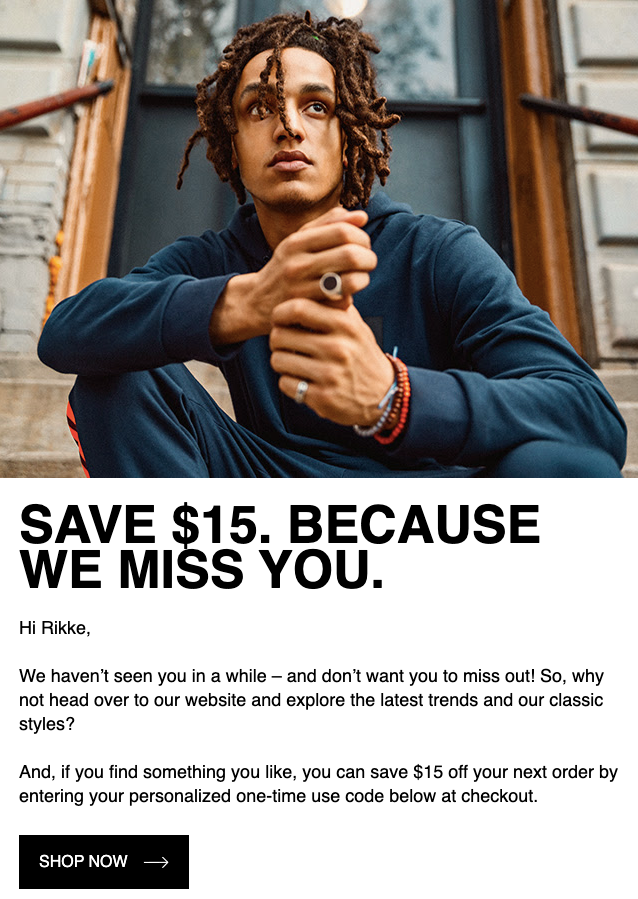 While the offer itself is attractive, this re-engagement email example works so well because of the copy.
While the offer itself is attractive, this re-engagement email example works so well because of the copy.
The implication here is that you’re such an important customer, Adidas has gone out of its way to win you around.
Which makes the $15 discount sound a whole lot more appealing.
Another interesting (to me, at least) point here.
In the marketing world, “engagement” is kind of a vague term. It means things like clicks, likes, and comments, rather than more concrete, meaningful marketing metrics (like sales and revenue).
Adidas clearly realizes that the best way to truly re-engage a disinterested subscriber is by persuading them to buy.
That way, they remember what first interested them about Adidas products, which means they’re more likely to keep opening the brand’s emails (and buying) in future.
And it only costs Adidas $15 off a sale.
2. The North Face: Drive an Immediate Action
Adidas showed us the value of re-engaging lapsed subscribers by compelling them to make a (discounted) purchase.
But what if the subscriber in question just isn’t ready to buy from you right now? Or what if you simply don’t want to look like you’re bribing people to engage with your emails?
Outdoors brand The North Face takes a slightly different, softer approach that doesn’t rely on the email recipient buying there and then.
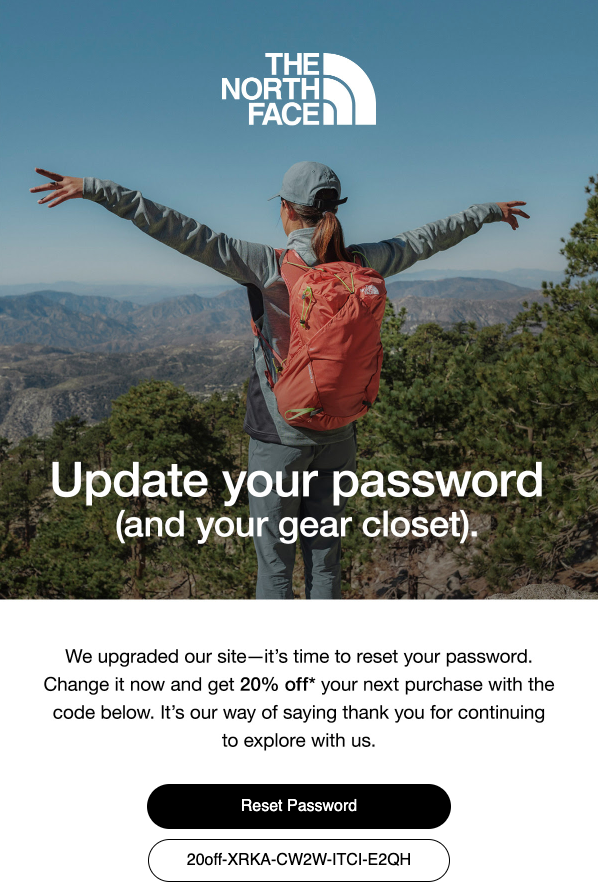 There’s a lot to like about this re-engagement email example.
There’s a lot to like about this re-engagement email example.
Firstly, it shows that The North Face cares about the online security of its customers.
It’s generally a good idea to regularly update your passwords anyway, so most people probably wouldn’t ignore an email telling them they need to do it now.
Secondly, it gives people an immediate reason to visit the brand’s website.
Once there, The North Face obviously hopes they’ll see a product they love, or at least remember why they liked the brand enough to sign up for its mailing list in the first place.
And thirdly, if they do find a must-have product, they’ve got a compelling reason to buy nowin the form of a 20 percent discount code.
That’s a lot of bases covered in a single re-engagement email.
3. Boozt: Remind People Why They First Subscribed
Every single person on your marketing list signed up for a reason.
They didn’t accidentally type their email address into a lead capture form.
Presumably, your email marketing is broadly geared toward reinforcing their original decision to subscribe.
That could mean highlighting:
- Your brand story
- Your features and benefits
- Your pricing
- Your best reviews and customer testimonials
- Your highest-quality content
Or something else entirely.
But when subscribers have lapsed, it’s clear that your messaging hasn’t been hitting home.
So it makes sense to use your re-engagement emails to reiterate why they subscribed in the first place.
Fashion ecommerce retailer Boozt does this with some smart email copywriting:
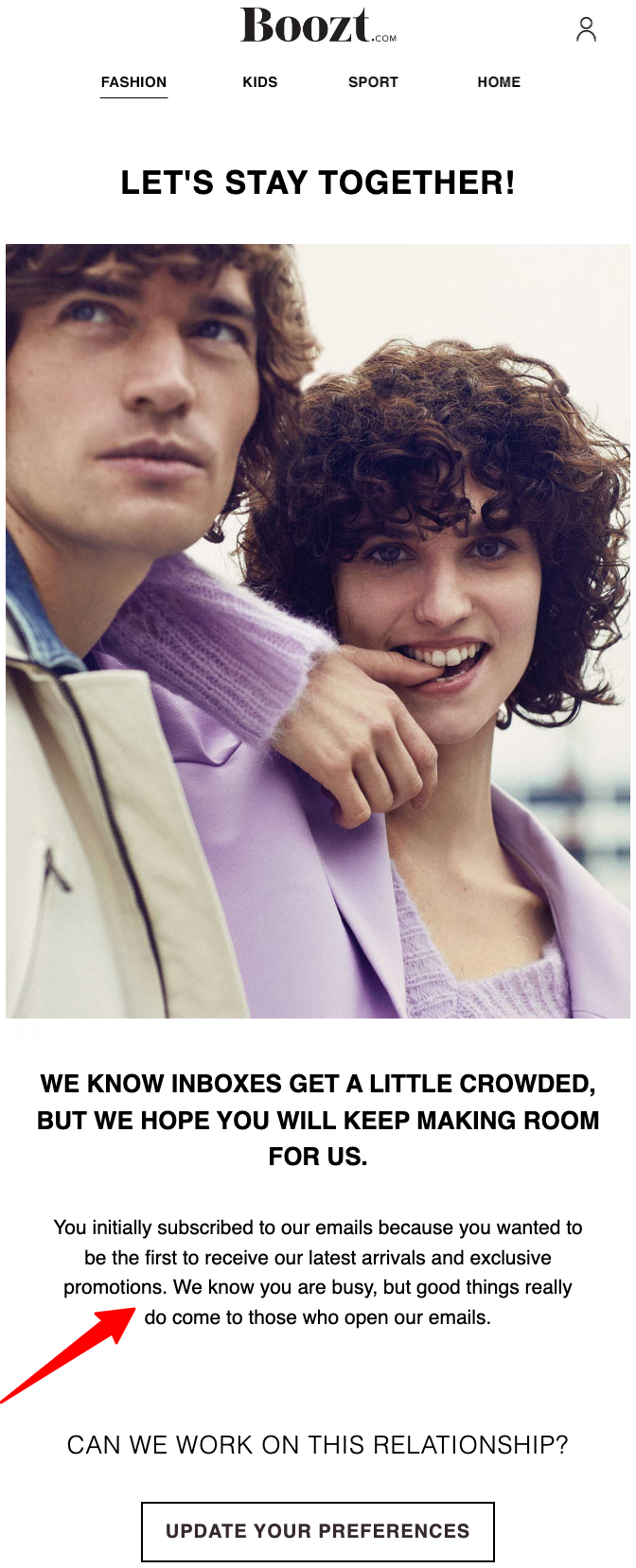 This works so well because it clearly spells out the benefits of subscribing to Boozt’s marketing list.
This works so well because it clearly spells out the benefits of subscribing to Boozt’s marketing list.
Not only that, but it doesn’t try to guilt-trip people into staying subscribed.
Fact is, everyone gets a ton of emails every day. The average person currently receives more than 330 emails a day, and that number is expected to exceed 375 emails a day by 2025.
So don’t blame your subscribers for lapsing.
Instead, explain why they might want to pay more attention to your emails going forward.
And if those reasons aren’t compelling enough, invite them to unsubscribe—because you definitely don’t want a list full of people who will never open your emails.
4. Joybird Furniture: Ask Subscribers If They Want to Continue
It’s important to note that the goal of a re-engagement campaign isn’t necessarily to keep people subscribed to your email list.
As I’ve already noted, email addresses are only valuable if they belong to people who actually open your emails.
A marketing list full of disengaged subscribers who have no interest in anything you’re saying is essentially useless.
In fact, it might even be actively damaging your marketing efforts by hurting your deliverability.
If someone isn’t engaging with your emails—and hasn’t for months—it’d be better if they weren’t on your list at all.
So don’t shy away from asking lapsed subscribers whether or not they actually want to keep receiving your emails, like Joybird Furniture does in this re-engagement email example:
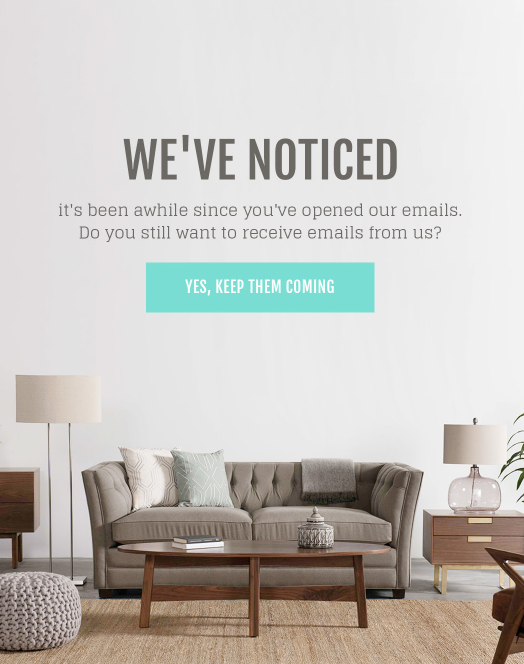 There’s really no bad outcome here.
There’s really no bad outcome here.
If they click “yes”, great—there’s a better chance they’ll engage with your emails more going forward.
If not, no problem, because removing them from your email list will actually improve your overall engagement rate.
5. Paperless Post: Write a Must-Click Subject Line
So far in this article, I’ve focused on what a good re-engagement email looks like once someone opens it.
In reality, that’s only half the battle.
Fact is, you’re trying to re-engage people who haven’t been opening your emails.
And in a world where only about 21 percent of emails are ever opened, there’s a good chance your lapsed subscribers simply aren’t going to take the time to click.
If you’re going to change their minds, you’ll need to craft a highly compelling subject line—something that succeeds where your previous email marketing efforts have failed.
Paperless Post does this by asking its subscribers a simple question:
 I’m not suggesting you use this exact subject line for your re-engagement campaigns.
I’m not suggesting you use this exact subject line for your re-engagement campaigns.
But it needs to be something that catches the eye and encourages the recipient to find out more.
Okay, so let’s say you’ve written the perfect subject line and won the click. What’s next?
In this case, Paperless Post chooses to offer a roundup of its best content:
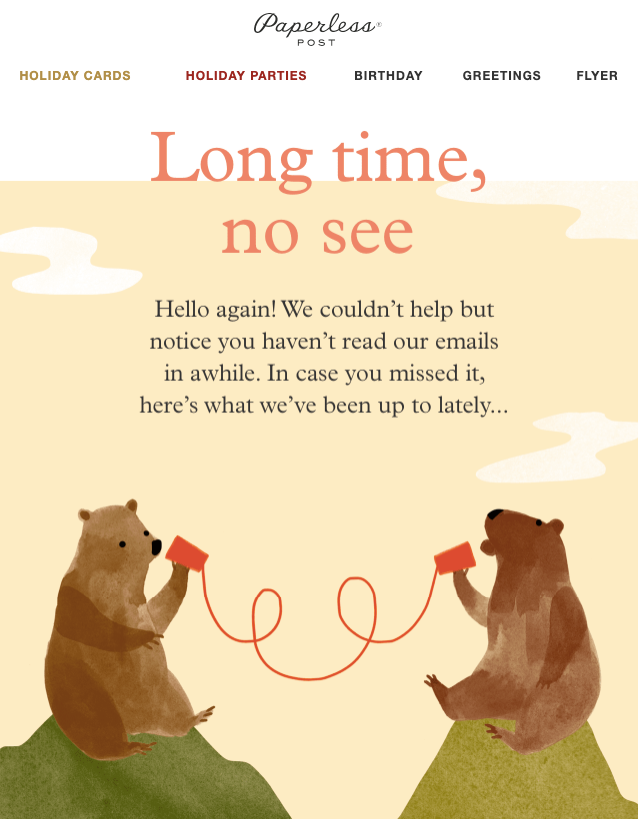 This is a smart approach.
This is a smart approach.
Presumably, if someone is receiving your re-engagement email, they won’t have seen your content for a long time (if ever).
So why not show them all the most unique, unmissable content you’ve created in the past few weeks?
That way, their first engagement (or re-engagement) with your brand will be off to the best possible start, making them more likely to click your emails in future.
6. Decomposition: Make People Feel Good About Subscribing
Let’s be honest.
As marketers, none of us is above a little psychological trickery.
In this re-engagement email example, Decomposition offers subscribers a direct choice: do you want to stay subscribed to our marketing emails, or opt out?
Sounds simple enough.
But it gets a little sneaky by adding two cutesy cat graphics to its email CTAs:
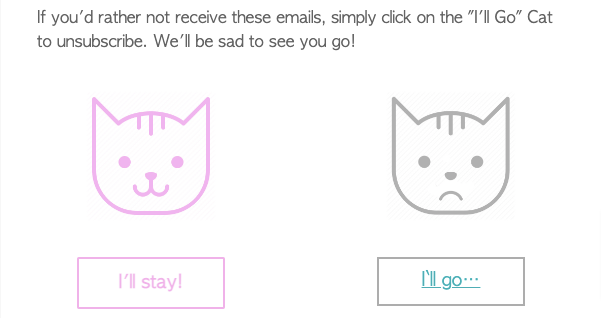 The message here is clear: if you click the “I’ll go” button, you’ll make the lovely cat feel sad.
The message here is clear: if you click the “I’ll go” button, you’ll make the lovely cat feel sad.
And no one wants that.
On the other hand, if you click “I’ll stay!”, you’ll be rewarded with a smiling cat. It makes you feel good about subscribing to Decomposition.
This tactic can be extremely impactful.
But if you’re going to use it, do it sparingly.
Your subscribers are only going to put up with a limited number of emails like this before smashing the “unsubscribe” button.
7. POPFLEX: Send a Breakup Email
Sometimes, the best way to encourage people to engage with your future emails is to threaten to take them away.
Because, on a psychological level, we all want what we can’t have.
One way to do this is by sending a breakup email that essentially says: “You haven’t been engaging with our recent messages, so we’re going to stop sending them.”
That’s precisely what POPFLEX does in this example.
It starts with a somewhat dramatic-sounding subject line that catches the user’s attention…
 …and follows up with some simple email copy that explains POPFLEX has unsubscribed us from its marketing list.
…and follows up with some simple email copy that explains POPFLEX has unsubscribed us from its marketing list.
 What makes this re-engagement email example particularly strong is that it doesn’t close the door forever.
What makes this re-engagement email example particularly strong is that it doesn’t close the door forever.
POPFLEX makes it clear that it really wants us to come back.
So it offers us a discount code to use if we ever find ourselves returning to its website in future.
Clearly, this is very much a last-ditch approach; something to send when everything else has failed.
But if none of your previous re-engagement efforts have worked, there’s really no shame in cutting the cord and saying “goodbye”.
Remember, it’s a good thing to clear your email list of disengaged subscribers.

Boost Your Email Marketing Engagement With Drip
The seven tactics in this article can be extremely effective for persuading lapsed subscribers to give you another chance.
But there’s another approach to improve your email engagement that I haven’t discussed here: send more engaging emails.
Often, that means creating more personalized email content.
Three-fifths of consumers say they expect brands to tailor experiences based on their preferences, so it’s hardly surprising that 90 percent of leading marketers say personalization significantly contributes to business profitability.
Drip makes it easy to segment everyone and personalize everything.
Want to reach people who browsed air fryers three months ago or added a new waffle iron to their shopping cart but didn’t convert?
Drip can do that by helping you set up highly specific audience segments that update in real-time.
That means no more spray-and-pray marketing blasts.
Instead, every single email you send can be dynamically personalized to the needs and preferences of individual subscribers.
Sounds good, right?
That’s why our platform is trusted by 27,000 marketers worldwide.
But don’t just take their word for it.
See for yourself by signing up for our 14-day free trial.

